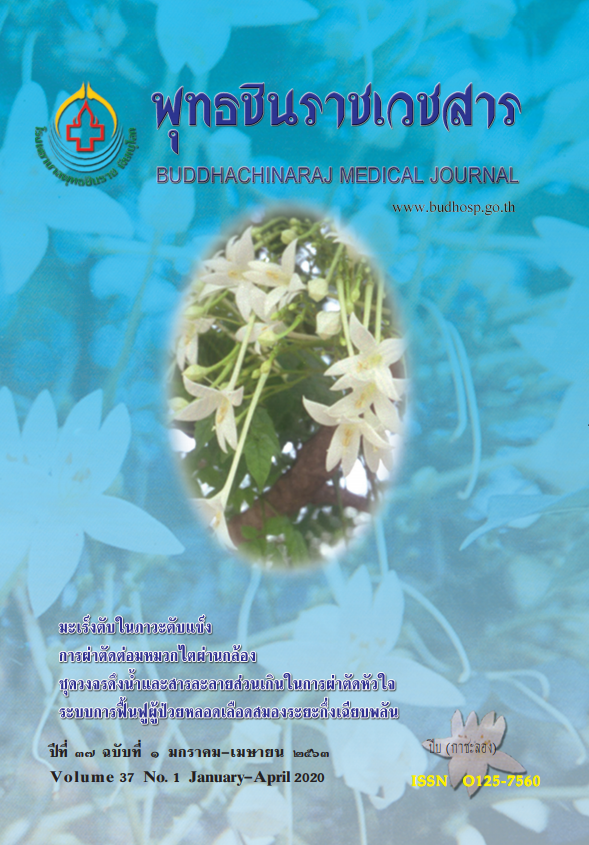ปัจจัยที่เกี่ยวข้องกับความเครียดจากการทำงานของบุคลากรในโรงพยาบาลทั่วไป
ความเครียดจากการทำงานของบุคลากรโรงพยาบาล
คำสำคัญ:
ปัจจัย, ความเครียด, บุคลากร, โรงพยาบาลบทคัดย่อ
การวิจัยแบบพรรณนานี้เพื่อประเมินปัจจัยที่เกี่ยวข้องกับความเครียดจากการทำงานของบุคลากรในโรงพยาบาลทั่วไป ศึกษาในเจ้า หน้าที่โรงพยาบาล 922 คน เครื่องมือที่ใช้ในการวิจัยประกอบด้วยแบบสอบถามข้อมูลส่วนบุคคล แบบสอบถามเกี่ยวกับปัจจัยจาก งาน และแบบวัดความเครียดจากการทำงานตามทฤษฎี Demand-Control Model ของ Karasek วิเคราะห์ความเกี่ยวข้องด้วย การทดสอบ chi-square ผลการศึกษาพบว่าบุคลากรมีความเครียดจากการทำงานในระดับสูงร้อยละ 19.5 โดยปัจจัยนอกงาน ได้แก่ อายุ รายได้ สถานะทางเศรษฐกิจ ภาระในครอบครัว กิจกรรมเพื่อคลายความเครียด และปัจจัยในงาน ได้แก่ แผนก ประสบการณ์การทำงาน การทำงานเป็นกะ วันหยุด การทำงานติดต่อกัน 7 วันต่อสัปดาห์ จำนวนชั่วโมงการทำงานที่ยาวนาน ลักษณะงานที่ต้อง สัมผัสผู้ป่วยโดยตรง ปัจจัยที่ก่อให้เกิดความเครียดระหว่างทำงาน (ผู้บังคับบัญชา ผู้ร่วมงานระดับต่ำกว่า ภาระ งานและผลตอบแทน) ภาระงาน (งานรักษา/พยาบาลผู้ป่วย งานหัตถการ งานประสานงาน งานประเมินผล และงานคุณภาพ) ความมั่นคงในหน้าที่การงาน การสนับสนุนทางสังคม และอันตรายในที่ทำงานเกี่ยวข้องกับความเครียดจากการทำงานอย่างมีนัยสำคัญ ทางสถิติ ดังนั้นผู้บริหารควรใช้ข้อมูลเหล่านี้จัดทำแนวทางป้องกัน เฝ้าระวัง และช่วยเหลือบุคลากรกลุ่มเสี่ยงต่อการเกิด ความเครียดสูง อีกทั้งเพิ่มการสนับสนุนทางสังคมในองค์กร โดยเฉพาะจากผู้บังคับบัญชาและเพื่อนร่วมงาน เพิ่มสวัสดิการ รวมทั้ง ปรับปรุงสิ่งแวดล้อมในโรงพยาบาลเพื่อลดความเครียดที่เกิดจากการทำงานของบุคลากรในโรงพยาบาล
เอกสารอ้างอิง
2. Sullivan E, Decker P. Effective leadership & management nursing. 6th ed. New Jersey:Pearson Education; 2004.
3. LinPC, Chen CH, Pan SM, Chen YM, Pan CH, Hung HC, et al. The association between rotating shift work and increased occupational stress in nurses. Occup Health 2015;57(4):307-15.
4. Levy SB, Wegman HD, editors. Stress. Occupational health: Recognizing and preventing work-related disease and injury. 4th ed. Philadelphia: Lippincott Williams & Wilkins; 2000.
5. Siangpror P, Rawiworrakul T, Keawboonchoo O. Factors correlated to job stress among nurse in specialized cancer hospitals, central region of Thailand. Health Sci Res 2014;8(1):17-27.
6. Thitaree K, Chaiwong W. A study on prevalence of work-related stress and relating factors among staff in a private hospital. Thammasat Med J 2019;19(1):115-32.
7. Janyam K. Job stress in Job Demand-Control Model: Causes, effects and prevention. Parichart J 2018;31(1):23-41.
8. Phakthongsuk P. Construct validity of the Thai version of the job content questionnaire in a large population of heterogeneous occupations. J Med Assoc Thai 2009;92(4):564-72.
9. Chaiear N, Suntisavee P, Maskasem S, Lathong S, Kaoyotha S, Jirapongsathorn S, et al. Sufficient exercise and exercise behavior among employees and lecturers at the Faculty of Medicine, Khon Kean University (KKU), Thailand. Srinagarind
Med J 2005;20(1):11-6.
10. Sakarinkhul P, Jirapornchareon W. Comparison of stress between patient-care personnel and other personnel at Maharaj Nakorn Chiang Mai Hospital. Lanna Public Health J 2006;2(3):190-7.
11. Pumfang S, Srisatidnarakul B. Factors of job stress for professional nurses in tertiary hospital. Kuakarun J Nurs 2015;22(2):141-53.
12. Hu SX, Luk AL, Smith GD. The effects of hazardous working conditions on burnout in Macau nurses. Int J Nurs Sci 2015;2(1):86-92.
13. Panthong M, Anusanti S, Keyuranon P. Relationships between work environment and professional nurses' stress of Prasat Neurological Institute. J Public Health Nurs 2018;32(3):151-64.
14. Runcharoen K. Stress-related factors and stress management of nurses in Srisaket Hospital. J Med Public Health, Ubon Ratchathani Univ 2019;2(1):1-10.






